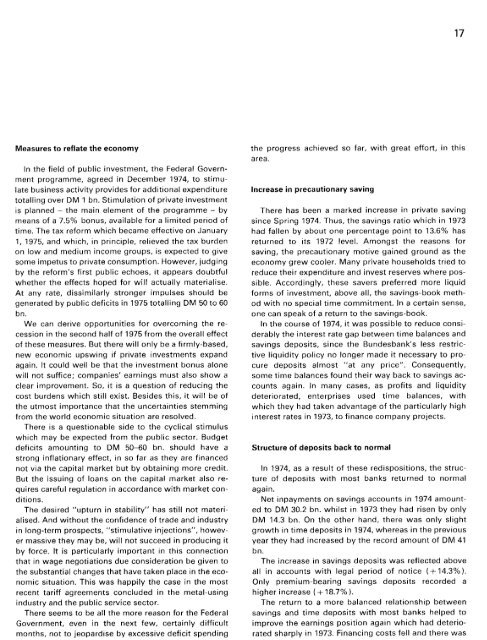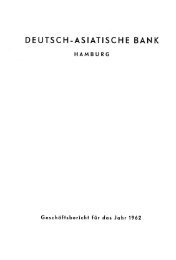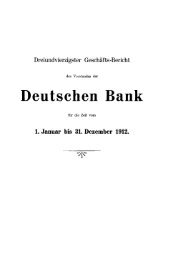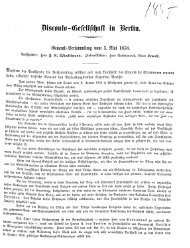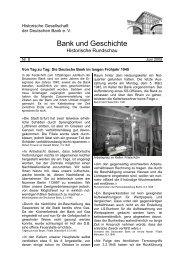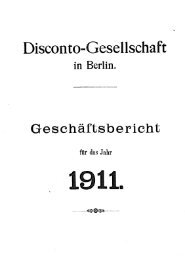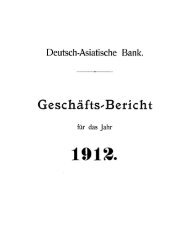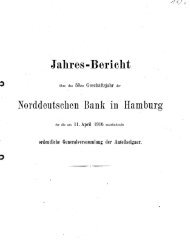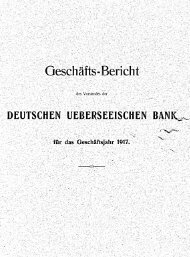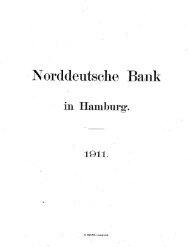Deutsche Bank 1 - Historische Gesellschaft der Deutschen Bank e.V.
Deutsche Bank 1 - Historische Gesellschaft der Deutschen Bank e.V.
Deutsche Bank 1 - Historische Gesellschaft der Deutschen Bank e.V.
Create successful ePaper yourself
Turn your PDF publications into a flip-book with our unique Google optimized e-Paper software.
Measures to reflate the economy<br />
In the field of public investment, the Fe<strong>der</strong>al Govern-<br />
ment programme, agreed in Decernber 1974, to stimu-<br />
late business activity provides for additional expenditure<br />
totalling over DM 1 bn. Stimulation of private investment<br />
is planned - the main element of the programme - by<br />
means of a 7.5% bonus, available for a limited period of<br />
time. The tax reform which became effective on January<br />
1, 1975, and which, in principle, relieved the tax burden<br />
on low and medium incoine groups, is expected to give<br />
some impetus to private consumption. However, judging<br />
by the reform's first public echoes, it appears doubtful<br />
whether the effects hoped for will actually materialise.<br />
At any rate, dissimilarly stronger impulses should be<br />
generated by public deficits in 1975 totalling DM 50 to 60<br />
bn.<br />
We can <strong>der</strong>ive opportunities for overcoming the re-<br />
cession in the second half of 1975 from the overall effect<br />
of these measures. But there will only be a firmly-based,<br />
new economic upswing if private investments expand<br />
again. It could well be that the investrnent bonus alone<br />
will not suffice; companies' earnings must also show a<br />
clear improvement. So, it is a question of reducing the<br />
cost burdens which still exist. Besides this, it will be of<br />
the utmost importance that the uncertainties stemming<br />
from the world economic situation are resolved.<br />
There is a questionable side to the cyclical stimulus<br />
which may be expected from the public sector. Budget<br />
deficits amounting to DM 50-60 bn. should have a<br />
strong inflationary effect, in so far as they are financed<br />
not via the capital market but by obtaining more credit.<br />
But the issuing of loans on the capital market also re-<br />
quires careful regulation in accordance with market con-<br />
ditions.<br />
The desired "upturn in stability" has still not materi-<br />
alised. And without the confidence of trade arid industry<br />
in long-term prospects, "stimulative injections", howev-<br />
er massive they may be, will not succeed in producing it<br />
by force. It is particularly important in this connection<br />
that in wage negotiations due consi<strong>der</strong>ation be given to<br />
the substantial changes that have taken place in the eco-<br />
nomic situation. This was happily the case in the most<br />
recent tariff agreements concluded in the metal-using<br />
industry and the public service sector.<br />
There seems to be all the more reason for the Fe<strong>der</strong>al<br />
Government, even in the next few, certainly difficult<br />
months, not to jeopardise by excessive deficit spending<br />
the Progress achieved so far, with great effort, in this<br />
area.<br />
Increase in precautionary saving<br />
There has been a marked increase in private saving<br />
since Spring 1974. Thus, the savings ratio which in 1973<br />
had fallen by about one percentage point to 13.6% has<br />
returned to its 1972 level. Amongst the reasons for<br />
saving, the precautionary rnotive yained ground as the<br />
economy grew cooler. Many private households tried to<br />
reduce their expenditure and invest reserves where pos-<br />
sible. Accordingly, these savers prcferred more liquid<br />
forms of investment, above all, the savings-book meth-<br />
od with no special time commitment. In a certain sense,<br />
one can speak of a return to the savings-book.<br />
In the Course of 1974, it was possible to reduce consi-<br />
<strong>der</strong>ably the interest rate gap betweeri time balances and<br />
savings deposits, since the Bundesbank's less restric-<br />
tive liquidity policy no longer made it necessary to pro-<br />
cure deposits almost "at any price". Consequently,<br />
some time balances found their way back to savings ac-<br />
Counts again. In many cases, as profits and liquidity<br />
deteriorated, enterprises used time balances, with<br />
which tliey had taken advantage of the particularly high<br />
interest rates in 1973, to finance company projects.<br />
Structure of deposits back to normal<br />
In 1974, as a result of these redispositions, the struc-<br />
ture of deposits with rnost banks returned to normal<br />
again.<br />
Net inpayments on savings accounts in 1974 amount-<br />
ed to DM 30.2 bn. whilst in 1973 they had risen by only<br />
DM 14.3 bri. On the other hand, there was only slight<br />
growth in time deposits in 1974, whereas in the previous<br />
year they had increased by the record amount of DM 41<br />
bn.<br />
The increase in savings deposits was reflected above<br />
all in accounts with legal period of notice (+14.3%).<br />
Only premium-bearing savings deposits recorded a<br />
higher increase (+ 18.7% ).<br />
The return to a more balanced relationship between<br />
savings and time deposits with most banks helped to<br />
improve the earnings position again which had deterio-<br />
rated sharply in 1973. Financing costs fell and there was


